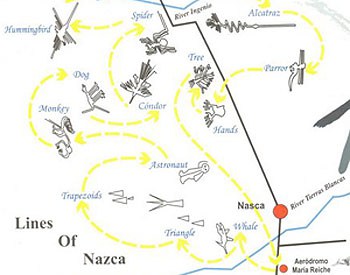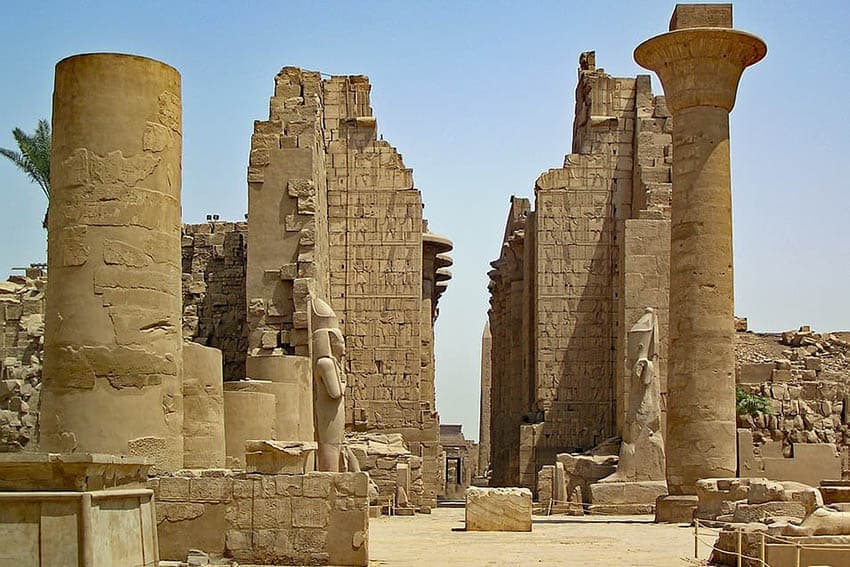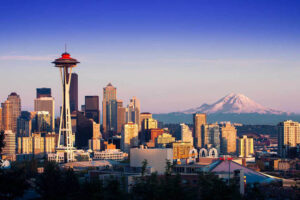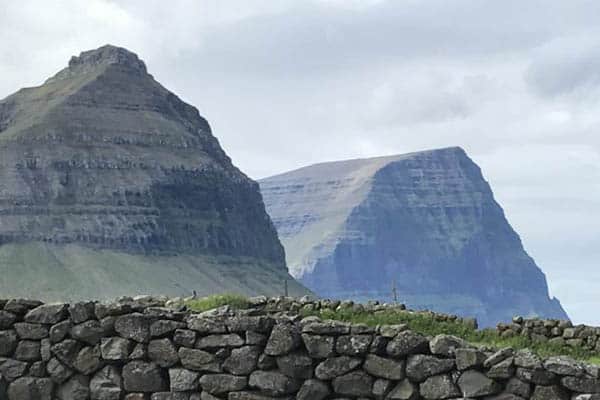The Nazca Lines in Peru: The Hummingbird Outside My Window
By Cassie Silva

Start Your Engines…
“We’re gonna die, We’re gonna die, We’re gonna die!” I mumble under my breath as the engine of the tiny plane I’m a passenger in finally sputters to life.
I promised myself long before coming to Peru that I’d never set foot in any airplane too small for in-flight beverage service, yet, here I find myself in an aged five passenger plane ready to depart from a tiny desert airport not exactly known for it’s pristine safety record.
I can’t help recalling stories about publicized deaths that have occurred above the Maria Reiche Aerodrome here in Nazca, Peru, as they unwittingly flash through my mind like news broadcasts on fast-forward.
Five French tourists were killed here fairly recently when their plane crashed after take-off, and several other planes have been involved in emergency landings over the past few years due to either mechanical problems or planes running out of fuel.
Roughly a decade ago, two similar aircraft collided in the skies above Nazca, killing ten Italian and German tourists. Thankfully, from what I understand, these companies are not in business anymore, proper procedures have been put in place, and flights are becoming safer. We are about to find out…
It’s Time for Take-Off
Our middle-aged pilot is yelling something, but even though this small plane is far from spacious, I can’t quite hear what he’s saying from my seat in the very rear of the plane. Hopefully, it’s not “Run for your life!”

I notice a pair of headsets dangling from a hook on the roof above me and pull them down over my ears to hear the voice of our Peruvian pilot above the noisy engine.
“Vamanos! Let’s go!” Pedro the pilot proclaims, and we begin our slow roll down the desert runway. I pull my small video camera from its case and begin recording what may very well be our final moments.
“Any last words?” I joke to my friend Michelle, aiming the camera toward her to capture her apprehensive expression.
She waves solemnly. “I love you, Mom!” I turn and begin filming out my window.
Michelle elbows me and points to a signposted prominently beside the pilot that reads “NO ACROBATIC MANEUVERS PERMITTED.” We snicker maturely, imagining ourselves doing somersaults and cartwheels around our small plane which is now putt-putting down the runway, gradually gaining speed. Desert scenery rushes by the window as we start to speed up.

I’m suddenly overcome by an odd sensation of utter weightlessness one doesn’t typically experience in larger planes, and I realize we have achieved lift-off.
We fly somewhat smoothly for a breathless minute, and we begin to relax when the plane suddenly lurches and we drop about ten feet in a split-second.
All five passengers gasp, and my digital video camera makes a horrible moaning noise and shuts itself off. Apparently it didn’t appreciate the sudden drop any more than we did – it refuses to turn back on, and so I stow it under my seat for safekeeping.
The plane bobs up and down a bit erratically and I can’t tell if it’s being piloted that way intentionally, or if we are being controlled by gusts of wind.
Each passenger nervously stares out his or her respective window in silence. We have an excellent view looking down on the city of Nazca, and all around us is dry, arid desert. I scan the desert eagerly, hoping to be the first to glimpse the mysterious lines we came up here to see.
The Mystery of the Nazca Lines

The Nazca Lines are a series of large geoglyphs, or giant drawings on the ground, located in the Nazca desert in Peru. These geometric shapes of immense proportions are believed to have been created by an ancient civilization sometime between the 4th and 8th centuries BCE, though some believe they were created more recently.

The lines seem to have been created through the removal of the reddish-brown desert rocks, which revealed the white Earth below. Since the desert is so dry and does not receive much wind, the lines remain uncovered.
Other countries, including the USA, Chile, Bolivia, and Egypt, also play host to mysterious geoglyphs, but the Nazca lines are considered the most complex, the most impressive, and the most mysterious.
There are many questions left unanswered that still baffle researchers today, about these lines that weren’t even spotted until the 1920’s when aircraft began flying over the desert.
How exactly were the lines made – and by whom? Why spend so many years creating something that can only be seen from the air – centuries before the airplane was invented?

Numerous theories abound over the years, some more far-fetched than others. Some people believe the lines are landing strips for alien spacecraft, while others believe the site is a giant astronomical calendar with each shape representing the movement of the stars.
Other theories are that the lines are a map of underground water resources, an agricultural calendar to regulate planting of crops, or that they may have served as running tracks during sporting competitions.
Some believe the lines were created to appease the Gods during times of drought, and sacrifices may have been carried out in some of the shapes.
Maria Reiche, for whom the Aerodrome was named, was the most famous researcher to have studied the lines. Her belief was that the lines show the direction of planetary events, such as solstices, and some shapes might represent star constellations.
Reiche believed the lines were created by the Nazcans, fairly recently, between 300 BCE and AD 800. In an attempt to link the two, artifacts recovered from around the lines have been radiocarbon dated to show proof they are Nazcan, but all this proves is that the Nazca people visited the lines – not that they created them. The lines themselves cannot be radiocarbon dated, thus the possibility remains that they existed long before the Nazca people came to inhabit the area.
Sit Back, Enjoy the View and Try to Relax…

The entire desert seems to be covered in wavy lines, but I can’t pick out any recognizable shapes. I begin hoping this isn’t one of those “cross your eyes and imagine really hard” type of illusions, like those puzzles in the Sunday paper where an image would bounce out at you when your eyes became relaxed enough.
All of a sudden, I spot an etching on the ground that I’m clearly not imagining. I whip out my camera and prepare to take a shot when the plane suddenly tilts severely to one side, and my stomach ends up somewhere between my ears.
“On your left, you see the Whale,” Pedro announces proudly. He tilts the plane even more so we can all gaze straight out the left-hand windows to the image on the ground – not that any of us have our eyes open at this point. “Now I will circle the Whale so the passengers on the right can see…”
We moan as the plane makes a sharp curve and another wave of nausea rolls through the cabin. Now I know why we were instructed not to eat breakfast before boarding.

After the Whale, we see the Triangle and Trapezoid shapes, followed by the Astronaut, Monkey, Dog, Condor, and Hummingbird.
An Unobstructed View
Pedro announces each image as we approach, then does several loops around the figure so each passenger has an unobstructed view for picture-taking.
If he took a look around the cockpit, he’d realize everyone’s eyes are closed, and we are slumping slightly forward concentrating very hard on not being sick.
I hold my camera up to the window and haphazardly shoot photos without glancing at the viewfinder. At least I’ll be able to prove I was here. I’ll admire the Nazca lines through my photos, once I’m safely back on solid ground.
The winds up here must be picking up, as our flight pattern seems a bit erratic. I wonder again how much control Pedro actually has, and how much we are being blown around. I dig my toes under the seat in front of me and try to ride out the sharp curves.
The airsick bag tucked into the back of the seat in front of me flaps reassuringly, as if to say, “I’m here if you need me”.The pilot’s concerned voice comes over my headset: “Is your friend okay?”I squinch my eyes open a crack and dare to peek beside me. Michelle’s eyes are tightly shut, and she refuses to open them when I elbow her.“I’m fine,” she mumbles, and I am free to focus on my own queasy stomach. I make eye contact with Pedro and nod that she is fine.
I notice the man in the front passenger seat is losing his breakfast into his airsick bag – I guess he missed the memo – and I quickly look away.After about fifteen minutes, I am getting used to the rolling conditions. I’m more alert as I snap photos of the geoglyphs, and even start wondering more about their history.
“Hey Michelle, can you pull out your guidebook? I want to know how old these babies are.”She lifts her head from between her knees and glares at me. “You have got to be kidding.” The plane lurches again and I lose all interest in history.
Back on Solid Ground
As soon as we feel the soft bump announcing our return to solid ground, we sit up straight and collect our belongings quickly.I fear that any second we will roar back up into the air and a crazed Pedro will yell, “Just kidding!”The second the plane lurches to a stop and the pilot announces “You may now…” we shove each other aside in our haste to exit the aircraft.
Pedro hops out and leans casually against the wing, puffing out his chest importantly. You’d think he had just landed a jetliner. “Who would like me to sign their flight certificate?”
Two passengers cover their mouths and run for the toilets, while the rest of us stay behind to get his autograph – hey, we’re tourists. If you can’t beat them join them. Michelle searches her pockets for change to buy a cool drink, while I try to catch my breath. We stumble to the airport, dizzy and nauseated, but proud that we now have certificates dubbing us “Honorary Aviators.“ That’s one more item to cross off life’s to-do list.

“Nearly puke while soaring above the Peruvian desert admiring humongous ancient drawings that look like a child’s oversized refrigerator art.” Check.
When to Go
The best time to fly is between 8 and 10 in the morning, or between 2 and 4:30 in the afternoon, as other times throughout the day can be delayed due to haze. It’s a good idea not to eat right before your flight. Planes won’t take off until full, so keep in mind you may be waiting around the airport a bit.
You can buy tickets in advance from a travel agency, or directly on-site from the airline offices. Purchasing a ticket at the airport will be only slightly cheaper, and will not include hotel pick-up or tours of the surrounding area.
Everyone in town will be willing to sell you a flight over the Nazca Lines – just make sure it’s with a reputable agency. Nazca is about a seven-hour drive from Lima, a two-hour drive from nearby Ica, and a 17-hour drive from Cuzco.
There are several bus agencies in Lima that stop at Nazca or Ica. Prices typically range from between $75 and $100 U.S. for a 35-minute flight, not including the airport tax. The prices depend on the season.
Flights will cost a bit more in the high season (June to September) than the low season (January to February) and can range from 35 minutes to 1.5 hours depending on how much you want to see. Tour packages often include hotel pick-up and drop off from Nazca or Ica.

Many tour packages also include an excursion to the nearby desert cemetery site of Chauchila, and some may include a dune buggy and sandboarding tour at the Huacachina oasis, or an excursion to the Ballestas Islands, both of which I highly recommend. It is also possible to take a (pricey) day tour to the Nazca Lines directly from Lima. Trip Advisor page.
An Alternate View
Those who aren’t up for the adventure of boarding a small Cessna aircraft to soar over the Nazca Lines can glimpse them from the Mirador (Lookout) Observation Tower beside the Pan-American highway, a few miles north of Nazca. This isn’t nearly as impressive a view, and you can only see a couple of the geoglyphs.
Taxi rides can be arranged to the Mirador.
Just a few Agencies that offer Nazca Line Flights: Peru Adventure Tours
Mystery Peru Alegria Tours Nasca Trails AeroParacas
Read Cassie Silva’s story: In the Land of Sand: Dune Surfing in Huacachina, Peru
The airport tax is 20 soles NOT 20 dollars – don’t be fooled!
 Cassie Silva is a writer, children’s theater director and globe-trotter who most recently spent two months traveling and volunteering her way across Peru.
Cassie Silva is a writer, children’s theater director and globe-trotter who most recently spent two months traveling and volunteering her way across Peru.
- Valentine’s Day Suggestions…for that Special Person - January 22, 2026
- Missouri Sports Travel Adventure: From Landmarks to Ballparks - January 21, 2026
- What First-Time Visitors Get Wrong About Visiting Iceland - January 15, 2026







